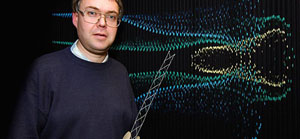Dr. Pekka Janhunen
The Wired article Riding the Solar Wind on a 30-Mile Sail said
“A spinning web of electrified wire 30 miles wide may become the spacecraft propulsion system of the future.A team from the Kumpula Space Center in Finland is proposing a huge electronic sail for spacecraft that may dramatically reduce journey times across the solar system. The giant sail, which would be twice the length of Manhattan, is made from about 100 wires spun up into a whirling disk. Electrified by an onboard, solar-powered electron gun, the negatively charged wires repel the positively charged protons of the solar wind, providing thrust.
The solar wind is a high-speed plasma stream blowing outward from the Sun. The average pressure of the solar wind is miniscule (a mere 2 nanopascals, or 0.2 grams of weight per square kilometer), which explains the need for such a large sail.
‘It’s such a small force that it’s really hard to imagine even,’ says Pekka Janhunen of the Finnish Meteorological Center, who leads the team behind the concept. ‘But it’s still enough to move the spacecraft because it’s doing it continuously over a large area.’ The sail is described in the latest issue of physics journal Annales Geophysicae.”
Pekka Janhunen, Ph.D. is Space Scientist at the Finnish Meteorological Center.
Pekka authored Magnetically dominated plasma models of ball lightning, and coauthored Simulation study of solar wind push on a charged wire: basis of solar wind electric sail propulsion, Alfvenic electron acceleration in aurora occurs in global Alfven Resonosphere region, Observations of substorm electrodynamics by using the MIRACLE network, Venus-solar wind interaction: asymmetries and the escape of O+ ions, Biological Feedbacks as Cause and Demise of Neoproterozoic Icehouse: Astrobiological Prospects for Faster Evolution and Importance of Cold Conditions, and HLLC solver for ideal relativistic MHD. Read the full list of his publications!
He earned his M.Sc. degree in theoretical physics and his Ph.D. degree in space physics. Watch Space “spider webs” could propel future probes.
